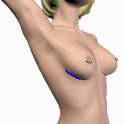Nipple Sparing Mastectomy: An Outstanding Surgery for Some Patients
Like many cancers, the treatment for breast cancer has gone through its evolution. Surgical treatment in the beginning and well into most of the 20th century consisted of the radical mastectomy. This procedure involved removal of the breast, pectoralis major muscle and all of the lymph nodes of the axilla or armpit through a large incision. This was usually followed by chemotherapy and high dose radiation that left the patient severely cosmetically deformed. This initial “cure” lead to severe upper extremity lymphedema (that was untreatable), late destruction of the chest wall ribs and death due to the initial treatment or it’s complications.
In the mid-1960’s the modified radical mastectomy came into existence. This surgery involved removal of everything that the radial mastectomy did except the pectoralis major muscle. As minimal as it may seem this was a huge surgical advance and allowed for much better reconstructive possibilities. This surgery was the standard of care well into the 1990’s. But in the late 70’s and 80’s innovative surgeons introduced the skin-sparing mastectomy that removed the nipple areola complex and used a much smaller incision.
Finally, in the mid-1980’s the nipple sparing mastectomy was introduced. However, as with many procedures the indications for its use had to be determined and therefore it was not widely used. Finally we have understanding and indications for its use.
The nipple sparing mastectomy is the greatest advance in breast cancer surgery. We have gone from removing everything associated with the breast and chest wall to only the breast tissue. This leaves the nipple areola complex, an excellent breast skin envelope and all of the muscles of the chest wall. In addition it may or may not be combined with a sentinel lymph node dissection. The incision for the nipple sparing mastectomy can be as short as 6cm, hidden in the inferolateral inframammary fold or breast crease (see the picture). This incision is only one centimeter longer than an incision used for a primary silicone breast augmentation! With this surgery an immediate breast reconstruction may be done with an acellular dermal matrix and tissue expander or permanent breast implant. I do not use a permanent breast implant in this setting because the final result will never be as good as a two-stage procedure using an expander first followed several months later by exchange to the permanent implant.

So why don’t we always do this fantastic surgery? The reason is tied to anatomy. Invasive ductal breast cancer means that the cancer has started in the milk duct of the breast and has spread through the duct into the surrounding tissue. All ducts are connected to the nipple so theoretically there could be cancer cells in the nipple. Remember this is only theory. Therefore current dictum (and lack of tort reform) states that all of the breast tissue and the nipple areolar complex should be removed to remove any possibility of recurrence. Therefore the current indications for nipple sparing mastectomy are really limited to DCIS (ductal carcinoma in situ), prophylactic mastectomy or non-cancerous breast disease. DCIS is cancer that has not mutated enough to become invasive through the milk duct wall. Given time it will.
Ten years ago DCIS was not considered cancer, but since we now know that if given time it becomes invasive cancer, then by definition it must be cancer (just not invasive). Other researchers and surgeons believe that the nipple sparing mastectomy should be considered even for patients with invasive cancers of less then 2cm in size, located at least 2.5cm from the areola (see indications). While this remains to be determined what is important is that we have outstanding surgeons like Dr. Virginia Chiantella, of Reston VA that are on the forefront of breast cancer surgery. Few surgeons can perform a thorough and complete mastectomy through such a small incision. It is this level of understanding, skill and caring that allows plastic surgeons like me to give patients, like our 31 year old, breasts that are imperceptible from normal breasts.